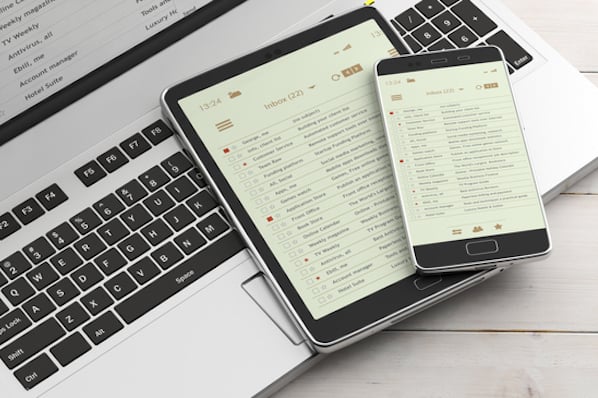When to Import & Export Contacts
Import and export are one of the easiest ways to pass contacts from one application or computer to another one. The best part? Nowadays, most applications handling contact lists have the option to export and import contact data in CSV and related formats. Here are some scenarios where importing and exporting is the solution:
- You are exporting a small database that won't grow at a fast pace. This could be, for instance, your personal phone contacts. In that case, chances are you won't miss out on new or updated data anytime soon.
However, if your phone contacts are in an app like Google Contacts and you want to take them to iCloud, Outlook, or another contact repository, there might be an easier workaround than importing and exporting. - It's a one-time import and export, not a business process. For example, when you are changing software providers and you just need to migrate your contacts from one app to another. But in this case, be sure to keep in mind the potential security risks listed below.
- The data in the app of origin won't change before its intended purpose is fulfilled. It's the case of some ad-hoc emailing lists or very timely campaigns. For instance, if you want to send out a 'thank you' email to a group of people who attended one of your events.
In any of the scenarios listed above, make sure that the format of your exported file matches the format expected by the application to which you'll import that file.
When Importing and Exporting Contacts Is Not Recommended
Importing and exporting will always be one of the easiest options out there, but sometimes it can be the wrong choice. In businesses with multiple systems and growing databases, using importing and exporting as an alternative to integrate can be a critical mistake.
In the following situations, importing and exporting could affect the quality of your data and your customer experience:
- When the contact data has to be available in two or more applications simultaneously. Operations people are constantly facing the challenge of connecting contact data between sales, marketing, customer support, or accounting applications. For them, importing and exporting contacts is rarely the right solution.
When you need to have the same data across apps, there's no better way than software integration. If you used import and export, you would have one version of your contacts in one app, and a different version in another. Keep in mind that your data grows and changes by the minute. - When importing and exporting might bring duplicates. This is a very common scenario. Let's say you want to export a contact list from your CRM and import it into an email marketing app. What if some of the contacts in your CRM already existed in your emailing tool? Will these people receive two emails?
Even if you import and export both lists in a CSV file and merge them (which will take you some time), you'll have people who gave different information in each app, and they'll likely become duplicate contacts. - When you are managing customer contact data. Avoid exporting lists with customer information and, most importantly, sharing it through email or business communications apps. Doing so is an unnecessary exposure to cyberattacks and it might even affect your business' reputation. Nothing less than 87% of consumers say they will take their business elsewhere if they would think their data is being handled irresponsibly.
Security Risks When Importing and Exporting Contacts
Data is a very valuable resource. Even if you are part of a small business, you can't underestimate the importance of data protection. The golden rule of data is that the less manual work involved, the better. And unfortunately, importing and exporting processes are all about manual labor.
Here are the two biggest risks to consider when importing and exporting contacts data:
Unintentional Data Mismanagement: This can go from accidentally deleting a contact to purging an entire contact list. Even if you've trained your employees to manage data responsibly, human mistakes can and will happen. That's why the best practice is to establish processes and operations that minimize the manual management of data.
Data Breaches: Even if you don't consider the information you collect as 'sensitive data', there are bad actors who could do a lot of damage by stealing a list of email addresses or phone numbers. As a matter of fact, 43% of data breaches victims are small businesses.
About Data Encryption
Especially when you are moving information from a piece of software or device to another one, a good way to make your import and export more secure is by encrypting your contact data.
Encrypted data, or ciphertext, is a security method to lock your data behind a safety code. You can encrypt lots of different formats of data, and the good news is that encrypting a CSV file is just a couple of clicks away.
Alternatives to Importing and Exporting Contacts
By now you should know that there's a lot of things to consider before you implement importing and exporting contacts as a business process. If you've realized that you'll need an alternative method, these are the options available.
Native Integrations: As your business grows, you'll need to add more and more apps to your software stack. Aware of this, the top business applications out there are constantly partnering up between them to create native integrations.
Native integrations are solutions available within your app that allow the system to 'talk' to other apps. They are basically a bridge between two applications where contacts, among other objects, can safely travel from one side to the other.
Integration Platforms as a Service (iPaaS): These are third-party software solutions whose primary function is to connect disparate systems.
iPaaS generally offers more flexibility and a broader range of applications to connect with. If you are considering using an iPaaS, make sure you understand how the different iPaaS options works.
In-house Integrations: If there's an IT or engineering department within your organization, they might be able to build an integration between your different business applications.
In big companies using their own servers and infrastructure, integrations are often built in-house. However, chances are they'll still pick an iPaaS or a native integration if it serves their purpose.
Smaller businesses using software as a service (SaaS) will likely avoid this option because of the time and costs involved.
Using Import & Export Wisely
CSV files and the import and export methods are here to stay. Being able to extract a version of your contact data and work with it from an easy-to-manage file is priceless. For personal or internal use, importing and exporting are, in most cases, a very good and simple solution.
All businesses, regardless of size, should consider the security risks involved, the changing nature of data, and how this process will impact the quality of your data. Then you can make an informed decision over the best way to pass your business contacts from one app or device to another one.
Contact Management Software












